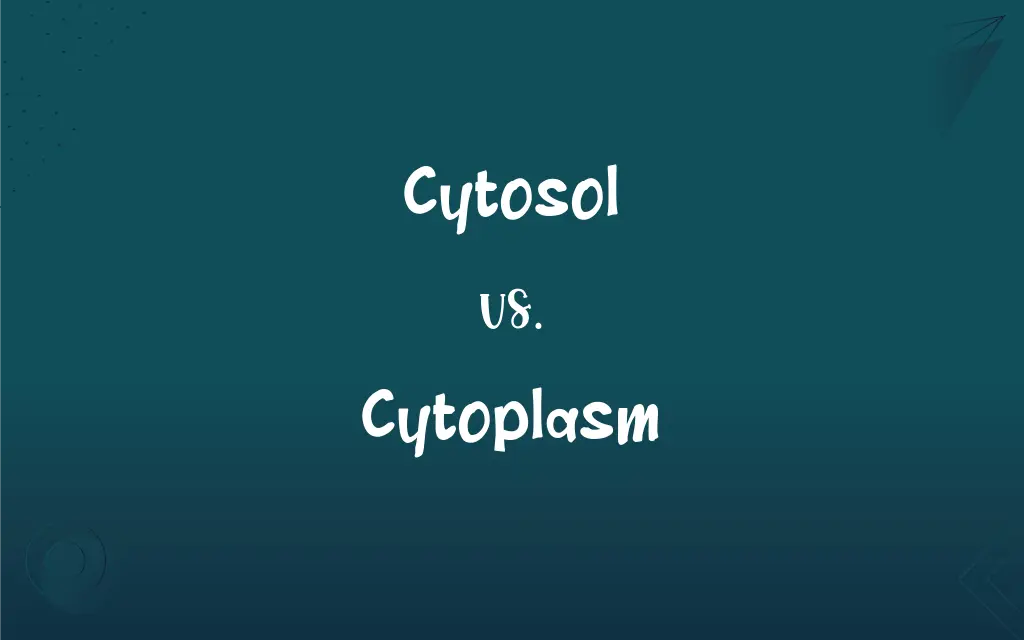Cytosol vs. Cytoplasm: What's the Difference?
Edited by Aimie Carlson || By Harlon Moss || Updated on October 9, 2023
Cytosol is the liquid component within the cell, whereas cytoplasm includes cytosol plus cell organelles, excluding the nucleus.

Key Differences
Cytosol, fundamentally, represents the liquid matrix inside the cell. It is the medium that facilitates the suspension of cellular organelles and is composed of water, salts, and organic molecules. The cytosol is integral in maintaining the cell's shape and consistency, offering a conducive environment for biochemical processes to take place, playing a pivotal role in cytoplasmic function.
Cytoplasm, on the other hand, is the cellular component enclosed by the cell membrane, which encompasses the cytosol and all organelles, except the nucleus. It holds the cell’s organelles, such as the mitochondria, endoplasmic reticulum, and Golgi apparatus, suspended in the cytosol, providing a supportive and protective environment for the cell's internal structures and mechanisms.
The primary difference between cytosol and cytoplasm resides in their composition and scope. While the cytosol is the semi-fluid substance that permeates the cell's interior, the cytoplasm embodies both the cytosol and the cellular organelles, encapsulating a larger cellular component. Cytosol permits various metabolic reactions to occur, such as glycolysis and protein synthesis, due to its enriched enzymatic content.
Conversely, cytoplasm, inclusive of cytosol and organelles, facilitates a broader array of cellular functions, contributing to processes like cellular respiration, protein modification, and vesicular transport. Cytoplasm supports cellular structures, ensuring they remain intact and stabilized, while also housing numerous metabolic pathways within its confines.
In essence, the cytosol is a subset of the cytoplasm, albeit a vital one. The cytosol acts as a scaffold, aiding in cellular transport and metabolism, while the cytoplasm, being a more comprehensive entity, serves to uphold the cell’s structural integrity and facilitate more diversified and complex cellular processes. The relationship between cytosol and cytoplasm demonstrates how intricate and organized cellular life is, each compartment contributing significantly to maintaining cellular life and function.
ADVERTISEMENT
Comparison Chart
Composition
Primarily composed of water, salts, and organic molecules.
Encompasses cytosol and all organelles except the nucleus.
Function
Facilitates metabolic reactions like glycolysis.
Hosts diverse cellular processes and supports organelles.
Scope
Pertains only to the intracellular fluid.
Represents the entire cellular content within the membrane, excluding the nucleus.
Inclusion of Organelles
Does not include organelles.
Includes organelles.
Volume
Occupies less cellular volume than cytoplasm.
Encompasses all cellular volume outside the nucleus.
ADVERTISEMENT
Cytosol and Cytoplasm Definitions
Cytosol
Cytosol serves as a site for signal transduction in the cell.
Signals from cellular receptors are often transmitted through the cytosol.
Cytoplasm
Cytoplasm acts as a buffer, protecting genetic material and organelles from damage.
The cytoplasm mitigates external pressures, shielding the interior components of the cell.
Cytosol
Cytosol is the aqueous component inside cells, excluding organelles and structures.
The enzymes within the cytosol facilitate various metabolic reactions.
Cytoplasm
Cytoplasm is vital for cellular metabolism and process facilitation.
The cytoplasm is the site for crucial metabolic processes and pathways.
Cytosol
Cytosol has a semi-fluid consistency that helps maintain cellular shape.
The semi-fluid cytosol ensures that the cell maintains its form.
Cytoplasm
Cytoplasm facilitates intracellular transport and supports molecular movement within the cell.
Nutrients and organelles move through the cytoplasm to reach their destinations within the cell.
Cytosol
Cytosol is involved in cellular metabolic processes, like glycolysis.
Glycolysis occurs in the cytosol, converting glucose into pyruvate.
Cytoplasm
Cytoplasm encompasses all cellular content within the cell membrane, excluding the nucleus.
The cytoplasm holds various organelles that perform specialized cellular functions.
Cytosol
Cytosol provides a medium for the suspension of organelles.
Cellular organelles are embedded within the cytosol.
Cytoplasm
Cytoplasm provides a milieu that supports the cell's structural and functional integrity.
The organelles are supported and protected by the cytoplasm.
Cytosol
The fluid component of cytoplasm, excluding the organelles and insoluble components such as cytoskeletal protein filaments.
Cytoplasm
The protoplasm enclosed by the plasma membrane of cell, excluding the nucleus in eukaryotic cells and cellular DNA in prokaryotic cells.
Cytosol
(cytology) The aqueous solution of a cell's cytoplasm, consisting of water, organic molecules and inorganic ions.
Cytoplasm
(cytology) The contents of a cell except for the nucleus. It includes cytosol, organelles, vesicles, and the cytoskeleton.
Cytosol
The soluble components of the fluid matter enclosed within the cellular membrane; the portion of the cytoplasm which remains after removal of particulate components.
Cytoplasm
The substance of the body of a cell, as distinguished from the karyoplasma, or substance of the nucleus.
Cytosol
The aqueous part of the cytoplasm within which various particles and organelles are suspended
Cytoplasm
The protoplasm of a cell excluding the nucleus
FAQs
What is cytosol?
Cytosol is the semi-fluid portion of the cytoplasm in which cellular organelles are suspended.
What is cytoplasm?
Cytoplasm refers to the content inside a cell, excluding the nucleus but including organelles, dissolved molecules, and the semi-fluid substance.
What is the function of cytosol?
The cytosol facilitates many metabolic reactions, acts as a solvent for cellular components, and transports molecules throughout the cell.
Is cytoplasm the same as cytosol?
No. Cytosol is a component of the cytoplasm. The cytoplasm includes both the cytosol and cellular organelles.
What happens to cytoplasm during cell division?
During cell division, the cytoplasm divides, ensuring that both daughter cells receive adequate cellular machinery and nutrients.
Do all cells have cytoplasm and cytosol?
Yes, all cells, whether prokaryotic or eukaryotic, have cytoplasm and, by extension, cytosol.
Is the cytosol acidic or basic?
The cytosol generally has a neutral to slightly alkaline pH, typically around 7.2-7.4.
Is cytoplasm found in red blood cells?
Yes, red blood cells contain cytoplasm, but they lack certain organelles like the nucleus in mammals.
What is the function of cytoplasm?
The cytoplasm provides a medium for cellular processes, houses organelles, and is involved in metabolic reactions, protein synthesis, and transport mechanisms.
What are the components of cytosol?
Cytosol mainly consists of water, dissolved ions, small molecules, and proteins.
Does the nucleus lie within the cytoplasm?
No, the cytoplasm surrounds the nucleus in eukaryotic cells, but the nucleus is not considered part of the cytoplasm.
What role does cytosol play in protein synthesis?
Ribosomes in the cytosol facilitate the process of translating mRNA into proteins.
Can metabolic reactions occur in the cytosol?
Yes, many metabolic reactions, such as glycolysis, occur in the cytosol.
Do plant cells have cytoplasm and cytosol?
Yes, plant cells, like all cells, have both cytoplasm and cytosol.
What gives cytoplasm its gel-like consistency?
The gel-like consistency of cytoplasm arises from the various proteins and macromolecules suspended in the cytosol.
Is cytoplasm present in bacteria?
Yes, bacteria, being prokaryotic cells, have cytoplasm but lack membrane-bound organelles.
Can substances move freely within the cytosol?
While many molecules can diffuse within the cytosol, the presence of various macromolecules and structures can restrict or facilitate the movement of specific substances.
How do toxins affect the cytoplasm and cytosol?
Some toxins can disrupt cellular processes by targeting components in the cytoplasm or altering the composition or function of the cytosol.
What is the consistency of cytoplasm?
The cytoplasm is gel-like or semi-fluid in consistency.
Do changes in cytosol composition affect cell function?
Yes, changes in cytosol composition can influence cell signaling, metabolic pathways, and overall cell health.
About Author
Written by
Harlon MossHarlon is a seasoned quality moderator and accomplished content writer for Difference Wiki. An alumnus of the prestigious University of California, he earned his degree in Computer Science. Leveraging his academic background, Harlon brings a meticulous and informed perspective to his work, ensuring content accuracy and excellence.
Edited by
Aimie CarlsonAimie Carlson, holding a master's degree in English literature, is a fervent English language enthusiast. She lends her writing talents to Difference Wiki, a prominent website that specializes in comparisons, offering readers insightful analyses that both captivate and inform.































































